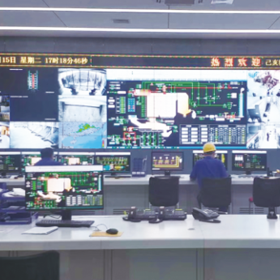◆ main functions
◆Overvoltage protection
During system operation, when the voltage is continuously higher than the set overvoltage protection value for a certain time (this time can be set), the protector is judged as "overvoltage" fault. The protector sends out the conventional "trip" command, the "fault" relay acts, and sends out the conventional alarm signal (intermittent buzzer alarm sound and fault indicator light on). The digital display automatically switches to the voltage value display state, displays the current voltage value in real time, and the voltage indicator light flashes at the same time. After a time delay (parameter 12) is set, if the voltage returns to normal, the alarm signal will be released, the relay will be disconnected and exit the fault state.
Note: any fault state can be manually exited in advance. Press the "parameter" key (even if it does not enter the parameter state) for a few seconds to exit the fault state. Use the "increase" and "decrease" keys to remove the buzzer alarm sound, but cannot exit the fault state in advance.
◆ Undervoltage protection
When the voltage is continuously lower than the set undervoltage protection value, the protector is judged as "undervoltage" state. If parameter 01 is selected as undervoltage and requires tripping (luyy), undervoltage will be treated as overvoltage, and conventional "trip" command and conventional alarm signal will be sent to enter the fault state. If parameter 01 is selected as undervoltage without tripping (luno), the undervoltage protection only sends a conventional alarm signal. In addition, the undervoltage protection can be turned off. When the undervoltage setting selection is lower than 50% of the rated voltage (49%), this function is turned off.
◆Overcurrent protection
During system operation, when the maximum one phase current of three-phase current continuously exceeds the set overcurrent setting value (105% ~ 200% IE) for a certain time (this time can be set), the protector judges it as "overcurrent" fault, sends conventional "trip" command and conventional alarm signal, and the "fault" relay acts. The digital display automatically switches to the current value display state, displays the current value at the tripping time, and the current indicator flashes at the same time. After a certain time delay is set, the alarm signal will be automatically released and the fault state will be exited. It is also possible to manually exit the fault state in advance. Overcurrent protection is also an inverse time limit control. Based on the set overcurrent delay tripping time, the protector automatically modifies the overcurrent action time according to the principle of "equal temperature rise". The greater the overcurrent, the faster the protection action.
◆Short circuit protection
When the maximum one phase current of the three-phase current reaches the short-circuit setting value (1.8 ~ 3.0ie), the protector judges it as a short-circuit fault, and the fault relay acts immediately. Other treatments are similar to overcurrent fault. Note that the current display value is the current value before tripping.
◆ Low speed protection (for generator)
Before "grid connection", low speed is not protected. After "grid connection", in some small power grids, the generator speed may be unstable. When the generator speed is less than the low-speed set value (30.0hz ~ 49.9hz), the protector judges it as a "low-speed" fault, sends a conventional "trip" command and a conventional alarm signal, and the "fault" relay acts. The digital display automatically switches to the frequency value display state, and displays the current frequency value in real time. At the same time, the frequency indicator flashes. After a period of time delay, if the generator does not turn to "flying", it will automatically exit the fault state. It is also possible to manually exit the fault state in advance. The low-speed protection function can select parameter 03 to cancel the removal of low-speed protection (FD --)
◆ Overspeed protection (for generator)
When the generator speed is greater than the overspeed setting value (50.1hz ~ 75Hz), the protector judges it as an "overspeed" fault and sends a conventional "trip" command and a conventional alarm signal. Other fault handling is the same as "low speed" fault handling after "grid connection". 7. Voltage input line drops (for generator)
When the voltage input line drops or the generator voltage is zero, it is judged as a "drop" fault, and the fault relay does not act, but sends a conventional alarm signal. When there are no other faults, the digital display will automatically switch to the frequency display state. Voltage and frequency display are 0000. When the voltage input is normal, it will automatically exit the fault state.





